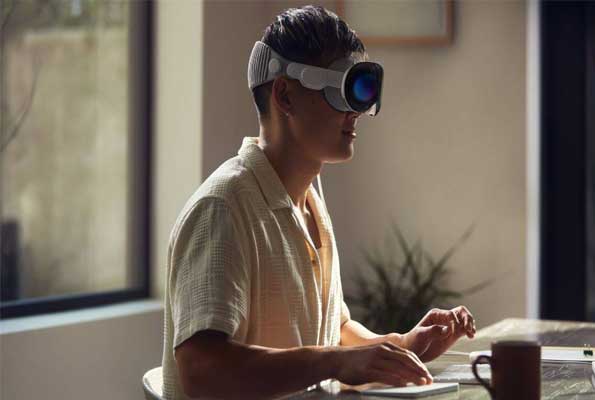Recently, Apple launched its Augmented Reality headset, during its 2023 Worldwide Developers Conference (WWDC23). Named ‘Vision Pro’, the device has a starting price of USD 3,499 and will be available at markets in early 2024. The headset looks like ski goggles and blends the virtual and augmented reality features, thus allowing its wearer to see digital content superimposed on their surroundings.
As per reports, users can virtually project the apps onto the space around them and control interactions with the apps through eye movement, hand gestures and voice.
Vision Pro will revolutionize personal computing by transforming the users’ interaction with the apps, apart from enabling people to capture and relive memories, enjoy entertainment, and connect with others through FaceTime.
Talking about the features, ‘Vision Pro’ incorporates a dual-chip design to deliver the desired performances. While the M2 chip provides sufficient computing power, the R1 one handles inputs, thus resulting in the seamless execution of actions and reduced motion sickness. The M2 chip also contributes to an 18% CPU performance increase, thus offering powerful performance for various tasks.
The AR headset also comes with a micro-OLED display technology, with a resolution of over 4K and boasting 23 million pixels. This high-quality display gives users an immersive visual experience, apart from enabling wireless streaming of Mac content to the headset.
The Vision Pro has also introduced an innovative ‘Persona Feature’ powered by ‘Machine Learning’. Cameras within the headset will scan the user’s face and create a lifelike digital representation. During video calls, this digital avatar will then mimic the user’s real-time expressions and body gestures, thus enhancing the communication experience further.
The AR headset also comes with an ‘EyeSight System’, which will allow the users to indicate their readiness for face-to-face conversation. An OLED screen on the headset’s exterior will display the user’s eyes, providing visual cues to others present in the virtual environment.
Users then will be able to reveal their digital eyes, in order to enable seamless interaction with their surroundings. Also, the device comes with an ‘Optic ID’, a new biometric system exclusively designed for the Vision Pro headset. This feature will bring LED light exposure into the play to analyze the user’s iris (a flat, coloured, ring-shaped membrane behind the cornea of the eye), comparing the human organ with an enrolled ‘Optic ID’ stored securely on the device. This ID will enhance the device’s data security by uniquely identifying individuals, even among identical twins.
What about the users who wear glasses? Apple addresses the needs of these customers by partnering with German optoelectronics giant Zeiss to offer optical inserts. These customized prescription lenses will get installed in the Vision Pro with the help of magnetic lens holders, thus eliminating the need to replace the headset’s lenses, while ensuring precise and comfortable viewing for the users.
Given the fact that cybersecurity risks are always involved with 21st-century tech, Vision Pro, apart from incorporating safeguards like Optic ID, will also be carrying privacy features like encrypted data storage and system-level processing of camera and sensor data.
Vision Pro hogged the limelight for being the flag bearer of Tim Cook-led Apple’s commitment to pushing the boundaries of technology and delivering a powerful and immersive mixed reality experience, which will set a new standard for spatial computing.
The event also saw the launch of a 15-inch MacBook Air featuring the M2 chip and an 18-hour battery life. With a starting price of USD 1,299, the variant will succeed the 13-inch MacBook Air.
Also comes the new iOS 17, which brings smart display-like features to iPhone, which can now double as a digital clock or a digital assistant when placed horizontally.
During the WWDC 2023, Apple also unveiled M2 Ultra, its most-powerful processor so far, when it comes to its desktop computers like Mac Pro and Mac Studio. The chip features a 24-core central processing unit and delivers 20% faster performance than M1 Ultra.
The event also saw the debut of a journaling app for the iPhone, called Journal that uses in-device machine learning to give writing suggestions curated from photos, location and other information that’s on the device.
Apple also displayed the upgrades like virtual keyboards and voicemails for its native apps ‘iMessage’ and ‘FaceTime’.
Similarly, Apple Watch has got new widgets. WatchOS 10 will add widgets for everything from weather information to calendar appointments on the Apple Watch. Deeper widgets’ support will also find a place in the latest iPad and Mac operating systems.
And last but not least, the tech giant has beefed up its desktop computers, by introducing a new version of its flagship Mac Pro with the M2 Ultra chip, starting at USD 6,999.
Image Credits: Apple



